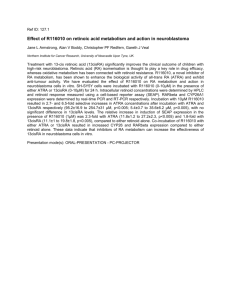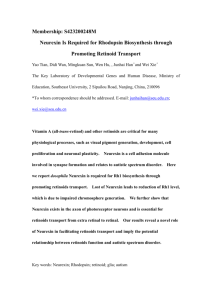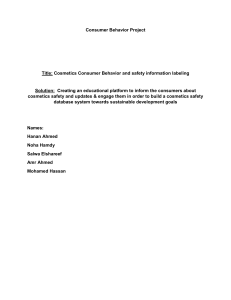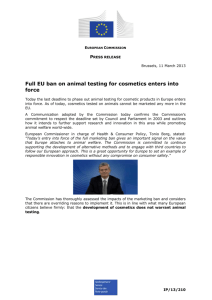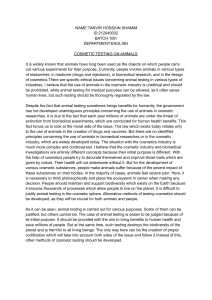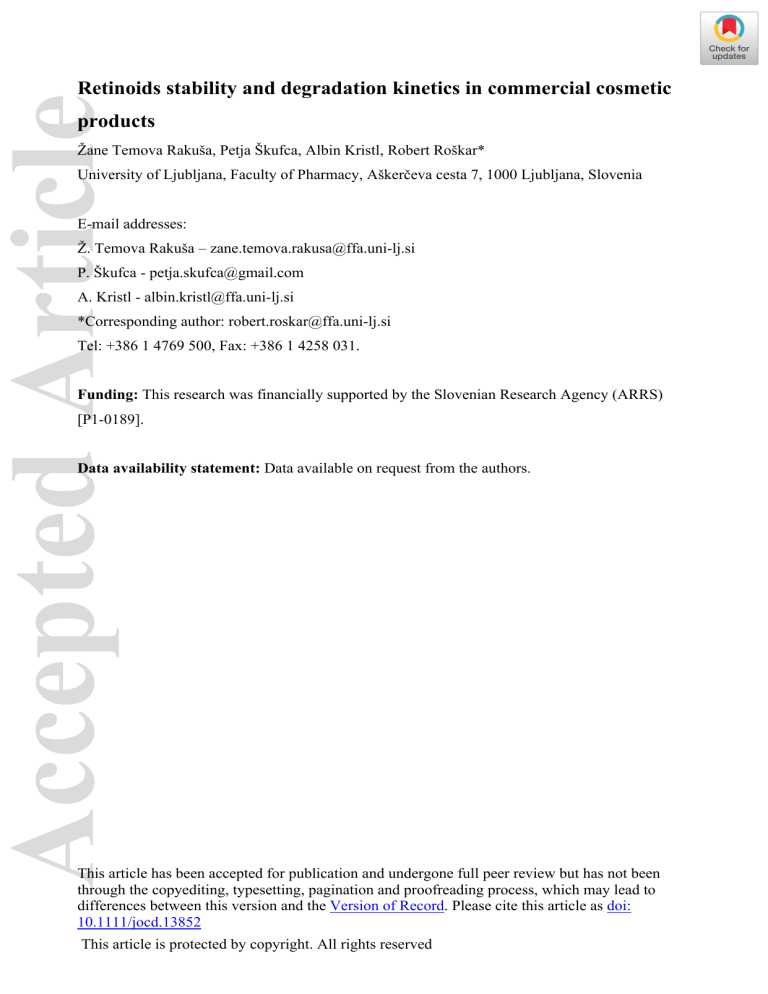
Accepted Article Retinoids stability and degradation kinetics in commercial cosmetic products Žane Temova Rakuša, Petja Škufca, Albin Kristl, Robert Roškar* University of Ljubljana, Faculty of Pharmacy, Aškerčeva cesta 7, 1000 Ljubljana, Slovenia E-mail addresses: Ž. Temova Rakuša – zane.temova.rakusa@ffa.uni-lj.si P. Škufca - petja.skufca@gmail.com A. Kristl - albin.kristl@ffa.uni-lj.si *Corresponding author: robert.roskar@ffa.uni-lj.si Tel: +386 1 4769 500, Fax: +386 1 4258 031. Funding: This research was financially supported by the Slovenian Research Agency (ARRS) [P1-0189]. Data availability statement: Data available on request from the authors. This article has been accepted for publication and undergone full peer review but has not been through the copyediting, typesetting, pagination and proofreading process, which may lead to differences between this version and the Version of Record. Please cite this article as doi: 10.1111/jocd.13852 This article is protected by copyright. All rights reserved Accepted Article DR. ŽANE TEMOVA RAKUŠA (Orcid ID : 0000-0001-8948-9129) Article type : Original Contribution Title: Retinoids stability and degradation kinetics in commercial cosmetic products Running head: Retinoids stability and degradation kinetics Abstract Background: Retinoids as dermatological agents are effective against acne, psoriasis, skin- aging, and other skin conditions. However, their susceptibility to degradation is a limiting factor for their wide-spread use. Objectives: Within this study, we aimed to provide comprehensive and evidence-based information on retinoids stability and degradation kinetics in commercial cosmetics, focusing on different factors affecting their stability. Methods: A validated HPLC-UV methodology was utilized for determination of the most common retinoids in cosmetics (retinol, retinyl palmitate, β carotene) and a newer promising retinoid (hydroxypinacolone retinoate). The stability of 16 retinoid derivatives in 12 commercial cosmetics was evaluated within 6 months of long-term and accelerated stability testing in addition to a one-week photostability study. Retinoid degradation in the tested formulations followed first-order kinetics, which was further applied to shelf-lives prediction. Results: Long-term and accelerated stability testing revealed retinoid instabilities in almost all products, resulting in a 0-80% decline after 6 months at 25 °C and a 40-100% decline at 40 °C, which were kinetically evaluated. Light degradation was more pronounced than temperature-induced degradation. Among the studied retinoids, the stability of the newer hydroxypinacolone retinoate was the most prominent. This study also identifies correlations between retinoid concentrations, price, formulation, and their stability in cosmetics. This article is protected by copyright. All rights reserved Accepted Article Conclusions: Retinoid instabilities were formulation depended and associated with lower contents than declared in some cosmetics. Retinoid chemical and physical stability in topical formulations need to be evaluated by real-time stability studies, instead of the more frequently used accelerated stability studies. Keywords: cosmeceutical, cosmetic formulation, cosmetics, retinoids, stability, vitamin A 1. Introduction The term retinoid refers to retinol and its analogues as well as carotenoids with vitamin A activity (beta carotene). In addition to the many different functions in the human body, retinoids also have various beneficial effects on the skin. Topical retinoids are effective in the treatment of acne, psoriasis, hyperpigmentation, photoaged or intrinsically aged skin, and dyschromia and are thus utilized in cosmetology and dermatology.1 However, two main issues are limiting the wide-spread use of topical retinoids: application site irritation (itching or burning sensation, erythema, dryness, peeling, photosensitivity)2 and their instability in cosmetic and pharmaceutical products. The latter is also addressed by the Scientific Committee on Consumer Safety (SCCS), Secretariat at the European Commission, Directorate General for Health and Food Safety, within the SCCS Opinion on vitamin A (retinol, retinyl acetate, retinyl palmitate), which emphasizes the lack of stability data of vitamin A in different product formulations and the need of proper stabilization through final formulations.3 Several studies in the literature have evaluated the stability of selected retinoids in pharmaceuticals,4,5 simple solutions,6,7 parenteral nutrition solutions,8–10 experimental cosmetic formulations,7,11–16 as well as commercial cosmetics.17–19 The main conclusions, which can be drawn by these studies, are as follows: the stability of retinoids depends on the medium, the pH value, and the presence of other antioxidants,13,14 and is also affected by environmental storage conditions, since retinoids are liable to light, heat, and oxidation exposure. Retinyl palmitate is the preferred retinoid in dermatological formulations due to higher thermal stability than retinol.7 However, a study on its photodecomposition in cosmetic creams demonstrated that its photoirradiation can result in the formation of toxic products associated with photocarcinogenesis.15 The instability of retinyl palmitate was also This article is protected by copyright. All rights reserved Accepted Article found to affect the formulation physical integrity.12 The stability of retinyl palmitate can be significantly improved by the presence of vitamin C and E,11 butylated hydroxytoluene, and UV filters.20 The published studies thus far on retinoids stability in topical preparation focus on a selected retinoid, typically retinol or/and retinyl palmitate, whereas the stability of a wider range of retinoids, often found in such preparations, such as β carotene and hydroxypinacolone retinoate (HPR), has not yet been described. Furthermore, the effect of storage conditions on retinoids, frequently present in commercial cosmetics has not yet been systematically and kinetically evaluated. Within this article, we present a comprehensive study on the stability of vitamin A derivatives in several topical products, including longterm, accelerated, and photostability testing, as well as evaluation of degradation kinetics, the applicability of accelerated testing to shelf-life determination, and associations between different factors affecting their stability. 2. Materials and methods 2.1. Chemicals and reagents All following materials: all-trans-retinol (≥99%), all-trans-retinyl palmitate (≥ 99%), β carotene (≥99%), butylated hydroxytoluene (BHT), as well as HPLC grade acetonitrile, methanol, n-hexane, and tetrahydrofuran were purchased from Sigma-Aldrich (Steinheim, Germany). Retinyl acetate (≥97 %) was purchased from Carbosynth (Berkshire, UK). Ultrapure water was obtained through a Milli-Q water purification system A10 Advantage (Millipore Corporation, Bedford, MA, USA). 2.2. Commercial cosmetic products 12 cosmetic products, including both products with declared retinoid content as well as products with listed retinoids as ingredients, were purchased in Slovenia in May 2019. These included products in various price ranges and formulations: day creams (Afrodita, Eveline, Eucerin, Green Line, L'oreal, Lekarna Ljubljana, Paula's Choice), day cream for men (Ombia), and serums (2×The Ordinary, Paula's Choice, and Revolution). 2.3. HPLC-UV analysis This article is protected by copyright. All rights reserved Accepted Article Retinoid contents in the tested commercial cosmetic products at each time point were measured by a validated HPLC-UV method21 using an Agilent 1100/1200 Series instrument (Agilent Technologies, Santa Clara, California, USA) equipped with a UV-VIS detector and ChemStation data acquisition system. In brief, the chromatographic separation was performed on a reversed-phase column Luna C18 (2) 150 × 4.6 mm, 3 μm particle size (Phenomenex, Torrance, CA, USA) at 40 °C. Mobile phase, consisting of water (A), acetonitrile (B) and acetonitrile: tetrahydrofuran (50:50, v/v) (C) in gradient elution mode was utilized as follows: (time (min); % A; % B): (0; 10; 5), (4; 5; 5), (8; 5; 5), (8.1; 10; 5) at a flow rate of 1 mL/min. Retinoids were monitored at characteristic wavelengths: 325 nm, except for β carotene (450 nm). Injection volume was between 10 and 40 μL, according to the retinoid amounts in the tested products. 2.4. Sample preparation Samples for retinoid quantification in at least triplicate were prepared following the validated method.21 The sample preparation procedure was adjusted to retinoid contents after preliminary testing of each cosmetic product. In brief, the samples for retinoid quantification in semi-solid cosmetic products were prepared by weighing a predefined amount (75-1,000 mg) of the cream into a plastic tube, followed by the addition of mobile phase B (2 mL) and sonication (5 min). Hereafter, 8 mL of n-hexane with BHT (500 mg/L) was added to the samples, followed by vortex mixing (5 min) and centrifugation (4,130×g, 25 ºC, 10 min). A part of the supernatant (0.5 - 1.5 mL), adjusted to retinoid content in the specific cream was evaporated to dryness under a stream of nitrogen at 40 °C (TurboVap LV, Caliper, Hopkinton-MA, USA). Dry residues were reconstituted with predetermined volume (0.5 - 2.0 mL) of mobile phase C with BHT (150 mg/L), followed by sonication (10 min), and vortex mixing (1 min). When necessary, the samples were centrifuged (16,200×g, 25 °C, 5 min) before analysis. The samples for retinoid quantification in liquid cosmetic products were prepared by diluting the serum (100-1,000 μL) with mobile phase C with BHT (150 mg/L) up to a predefined volume (5 - 50 mL), depending on retinoid content. The samples were sonicated (10 min), filled up to the mark of the volumetric flask with the same solvent, and vortexed (5 min). When necessary, the samples were centrifuged (16,200×g, 25 °C, 5 min) before analysis. 2.5. Stability study This article is protected by copyright. All rights reserved Accepted Article The cosmetic products (Section 2.2.) were exposed to long-term, accelerated as well as stress testing under the influence of UV and daylight. Stability samples at each time point were prepared and analyzed in triplicates following the procedures described above (Section 2.4.). 2.5.1. Long-term and accelerated stability testing Long-term and accelerated stability testing was performed following the ICH Q1A (R2) guidelines.22 Long-term stability testing was conducted on the cosmetic products in their original packaging under expected storage conditions (25 °C and 60% relative humidity (RH)). Accelerated stability testing was conducted at 40 °C and 75% RH on predefined amounts of the cosmetics, which were previously weighed and stored in closed plastic tubes, protected from light. The samples for both long-term and accelerated stability testing were stored in climate chambers. The cosmetics stored at 25 °C were occasionally opened to simulate their real-life usage. The content and appearance of all samples were evaluated immediately after opening (initial content) as well as at regular time points during 6 months period: after 1 week, 2 weeks, 1, 2, 3, and 6 months. 2.5.2. Photostability testing The cosmetic products for stability testing were also exposed to photostability testing following the ICH Q1B guidelines (ICH Q1B, 1996), option 2 in a climate chamber with a light module (ICH 260L, Memmert, Büchenbach, Germany). Predefined amounts of the cosmetics were initially weighted, stored in closed transparent plastic tubes, and analyzed after 1, 3, and 7 days. 2.5.3. Kinetic studies Retinoid concentrations were obtained at different time points during the stability testing. Zero, first and second order of degradation was calculated for each sample. The most appropriate kinetic order (according to the correlation coefficient) was selected and applied for the calculation of degradation constant (k) and shelf-life, which was defined as a 10% decline in concentration (t90%). This article is protected by copyright. All rights reserved Accepted Article 3. Results and discussion 3.1. Stability of retinoids during 6 months of long-term and accelerated stability testing Retinoid stability in commercial cosmetic products in various formulations was evaluated after their opening, during 6 months of storage at room temperature and elevated temperature. The obtained results showed a significant decline of retinoids practically in all tested products (Fig. 1). The decline in retinoid contents after 6 months at 25 °C ranged from 0 to 80%. The decline was greater at higher storage temperature in all samples (40-100% at 40°C), resulting in total degradation of the retinoids in almost one-third of the tested products. Even in the most stable formulation, 40% degradation was observed after 6 months at 40 °C (R (F3) in Fig. 1). No significant difference was observed between the stability of retinol (25-93% remained) and retinyl palmitate (20-100% remained) after 6 months of storage at 25 °C. The stability of β carotene was better in both tested formulations at the same storage conditions (83% remaining). However, because of the smaller sample size and its very low content, we cannot draw any concrete conclusions. The stability of the newer retinoid (HPR) was also evaluated, which has not yet been studied in the accessible literature. Its structure was confirmed by LC-MS before the stability study.21 HPR was found very stable in the tested formulation at 25 °C after 6 months (95% of the initial content remained). High chemical stability was also evident at 40 °C (97% of the initial content remained after 3 months). However, physical instability was observed during the last 3 months of storage at elevated temperature, resulting in a stratification of the product. Retinoid concentration in the tested formulations is evidently not the determining factor for their stability since extensive degradation (around 70%) was observed in both formulations with the highest retinoid contents (Fig. 1). The most important factor in ensuring their stability was the formulation itself, which was not guaranteed by the product price. The formulations with the lowest retinoid degradation (R (F3), R (F5), R (F7), Rpal (F3), and HPR (F8)) belong to the lower-mid price range (up to 50 € per 50 mL), whereas the tested highest-priced products were subjected to more extensive degradation. 3.2. Effect of temperature on retinoid degradation kinetics This article is protected by copyright. All rights reserved Accepted Article Degradation kinetics could offer more in-depth insights into retinoid instability in topical formulations but are only rarely utilized within stability evaluation in cosmetic formulations. We assessed this issue by initial determination of the best model to describe the degradation kinetics of retinoids. Therefore, zero, first, and second-order models were tested. The decrease in retinoid concentration followed first-order kinetics in most products (R2 > 0.99, Table 1), which is in agreement with previous reports on retinol24 and retinyl palmitate.12 Shelf-lives, defined as 90% of the initial retinoid concentration, were also calculated for each tested cosmetic product at both temperatures (Table 1). The newest generation retinoid (HPR) was the most stable retinoid among the tested formulation at ambient temperature, with more than two-fold longer shelf-life compared to the second most stable retinoid (Rpal (F3)). Excluding the new retinoid (HPR), which significantly deviates from the others, the average shelf-life at 25 °C was about 2 months; in one-third of the tested cosmetics, it was < 1 month. Although the actual stability in sealed packaging may be better, the obtained shelf-lives are much shorter than the generally declared 6-months or 12-months shelf-lives after opening. At elevated temperature (40 °C), the shelf-lives were significantly shortened to an average of < 14 days. The effect of the temperature on retinoid stability can most readily be observed from the ratio of rate constants k40°C and k25°C (Table 1). The increase in temperature did not affect the stability of retinoids in some formulations (F11 and F6 in Table 1), while significantly accelerating the degradation of others (up to 80-fold for Rpal in F2). On average, 15 °C higher storage temperature increased the reaction rate constants by a 5.2-fold (excluding Rpal (F2), which deviated significantly from the rest), but considering the vast differences (1.0-78.7), it can be concluded that the thermal stability of the cosmetic products is formulation dependent. Since higher temperature increased the retinoid degradation rates to a very different extent, the results of the accelerated tests allow only limited extrapolation to ambient temperature. In cases when elevated temperature caused physical changes (2 cases in our study, Section 3.3.) accelerated stability studies were not predictive of their long-term chemical stability or their shelf life. Therefore, stability information needs to be obtained from real-time stability studies, even though the faster accelerated stability testing is usually performed in the cosmetic industry, to predict the stability of the cosmetic product.12 Accelerated stability studies can however be useful in showing the impact of short-term deviations from the stated storage conditions, which might occur during transport or storage. 3.3. The cosmetics appearance during storage This article is protected by copyright. All rights reserved Accepted Article All tested cosmetics were also evaluated for changes in appearance during six months of stability study at both storage conditions. Macroscopic separation was observed in two of the 12 tested products. Phase separation was observed in one liquid dosage form (o/w emulsion), which did not occur before three months of storage at 40 °C, while no change was observed at 25 °C. Phase separation was also observed in one semisolid dosage form, where the oil phase had visibly accumulated on the surface of the cream after one month of storage. 3.4. Retinoid contents at shelf-lives Degradation kinetics (Section 3.2.) was applied to determine the remaining retinoid contents at the shelf-lives of the tested cosmetics, as determined and declared by their manufacturers. For such purposes, stability data at ambient temperature, simulating their real-life usage, was utilized. Most cosmetics declared a 6-months or 12-months shelf-life after opening. Less than one-third of the tested cosmetics contained ≥80% of the initial retinoid content at their shelflives, while more than half of them contained about or less than half of the retinoid contents (Table 2). The predicted retinoid contents after 6 months of storage were comparable with the determined retinoid contents within the stability study (Table 2), thus demonstrating the applicability of the employed concept for shelf-lives prediction. 3.5. Relation between retinoid concentrations and their stability The effect of retinoid contents on their stability was also assessed in the tested cosmetics. Higher found concentrations did not have a stabilizing effect on the retinoids, although in some of the tested products inversely proportional concentration dependence can be observed (Fig. 2). Interestingly, retinoids present at higher concentrations seem to be more susceptible to degradation. As no evident correlation between retinoid concentrations and their rate constants implied that their stability is formulation dependent, rather than concentrationdependent. 3.6. Relation between the product price and retinoid stability In the further assessment of factors affecting retinoid stability, the financial aspect was also included. The considered prices are the retail prices of the commercial cosmetics, purchased in May 2019, calculated to a uniform volume (50 mL). The results for retinoid stability (expressed with their first-order reaction rate constant) in relation to the price of the tested This article is protected by copyright. All rights reserved Accepted Article products are shown in Fig. 3. As can be seen, the cosmetic product with the highest retinoid degradation rate is the least expensive among the tested cosmetics. However, it is also evident, that the two most expensive cosmetics, which specifically highlight their high retinoid contents, do not provide adequate stability within their formulations. Among the more affordable cosmetics (≤ 20€) the reaction rate constants are very diverse. The cosmetic product with the lowest reaction rate constant also belongs to this price range. It can be concluded that the proper formulation of the cosmetics in terms of the active compounds stabilization is not guaranteed by the price of the product. 3.7. Effect of the formulation on retinoid degradation kinetics The tested cosmetics were in liquid (serums) or semisolid dosage forms (creams). In general, retinoids are unstable in water-based liquid preparations. However, this was not observed in our study as the most stable retinoid (HPR) was formulated in liquid dosage form (F8 - o/w emulsion). In the remaining two liquid formulations, where retinoids were dissolved in various oils, their stability was comparable to that in semisolid dosage forms and was most likely associated with the type and quality of the oil (especially peroxide content) as well as the added excipients.25 No pattern was observed in retinoid degradation rates in different dosage forms (Table 3). Almost all cosmetics involved in the stability study contained some stabilizers, including antioxidants (e.g. BHT, vitamin C, E) and chelating agents (e.g. EDTA, citric acid), listed in Table 3 in the same order as on the ingredient list. Vitamin E derivate - tocopheryl acetate is also listed because some products state its antioxidant activity. However, it acts as an antioxidant only after its hydrolysis in the skin but does not have a stabilizing (antioxidant) effect during the storage of the formulations.26 The stabilizing effect of other listed stabilizers on retinoids has already been established.4,7,20 However, retinyl palmitate was the least stable in the formulation with the largest number of added stabilizers, whilst the most stable retinoid formulation contained only one stabilizer (EDTA). Therefore, it can be concluded that the presence of various stabilizers does not assure the stability of retinoids in cosmetic products. Their stability in formulations is more likely dependent on the amount of added stabilizer then on the presence of different stabilizers or their larger number. Since manufacturers do not provide information on the contents of the added stabilizers, this thesis cannot be confirmed and would require further studies. This article is protected by copyright. All rights reserved Accepted Article 3.8. Photostability evaluation Photostability testing was performed following the ICH Q1B guidelines23 to evaluate retinoid photosensitivity in the tested products. All tested retinoids were found overall photosensitive with degradation rates dependent on the formulation. Retinol remained at highest amounts (64-90% of the initial content) in three out of four tested semi-solid products; however, it degraded completely in the remaining two liquid products. Retinyl palmitate and β carotene were found more liable to photodegradation, resulting in almost complete degradation in all of the tested semi-solid products (Fig. 4), which is in accordance with the literature data.7 Contrary to stability results at elevated temperature, exposure to light also significantly affected the newer retinoid (HPR), resulting in a 40% decrease after one week. On average, only 20% of the initial retinoid content remained after one week of light exposure, ranging from the total (100%) to a 10% decline of retinoids. When comparing different retinoids after the same exposure time to a single factor of instability (elevated temperature and light exposure), light degradation was substantially more pronounced than temperature-induced degradation (Fig. 4). To achieve adequate photostability, the addition of UV filters to the cosmetics should be considered, which were not listed in any of the daycare products, subjected to the stability study. 3.9. Effect of retinoid stability on their content The obtained results for degradation kinetics during long-term and accelerated stability testing also provided certain explanations to the observed deviations between the declared and found retinoids in the five tested cosmetics with declared retinoid content. The greatest deviation from the declared content (0.3% retinol), was observed in one of the tested serums (F2), where retinol was not found (below LOQ – 6.2 nanograms per gram of cosmetic product). In this product, we evaluated the stability of the found retinoid – retinyl palmitate (marked Rpal (F2) in Table 1). Considering its high degradation rate (t90% < 15 days at room temperature) and the most significant temperature effect on its degradation, it is evident, that this formulation does not provide adequate chemical stability of retinoids. The stability testing of the cosmetic product, which contained half of the declared retinol (53.7 ± 1.5 %), revealed that in this formulation retinol had the highest degradation rate at room temperature (R (F4) in Table 1). Its inadequate stabilization through this formulation is evident. Significantly lower content was also determined for HPR in F8 (5.3 ± 2.0 %), for which This article is protected by copyright. All rights reserved Accepted Article stability was not an issue. HPR was the most stable retinoid with a shelf-life of about one year. Since HPR commercial standard was not available, its quantification was based on its structurally most similar retinoid - retinyl acetate. Therefore, slight deviations are possible, which, however, are not the reason for such low content. In the remaining two cosmetic products with specified retinoid contents, higher contents than declared were detected: R (F1) - (131.8 ± 2.2 %), and R (F5) - (128.5 ± 3.3 %). 4. Conclusions Retinoids as dermatologic agents are effective in the treatment of acne, psoriasis, photoaged and intrinsically aged skin as well as other skin diseases. However, they require proper stabilization through their final cosmetic or pharmaceutical formulations. In this paper, we evaluated the stability of the most commonly used retinoids in commercial cosmetics in various formulations. Long-term and accelerated stability testing revealed retinoid instabilities in almost all tested commercial cosmetics, which were formulation dependent, wherein not dependent on the retinoid concentration nor the product price. Within photostability evaluation of the products, all tested retinoids were found overall photosensitive, among which retinol was found the most stable. Retinoid degradation in the tested formulations followed first-order kinetics, which was further applied to shelf-lives prediction. Accelerated studies were found not suitable for the prediction of the quantitative chemical stability of tested products. Most cosmetics declared a 6-months or 12-months shelf-life after opening and less than one-third of the tested cosmetics contained ≥80% of the initial retinoid content at their shelf-lives, while half of them contained about half of the retinoid contents. Based on the obtained results after long-term and accelerated stability studies, it is evident that lower retinoid contents in some of the commercial products, which specifically defined their retinoid contents, are a consequence of their instability. Such stability evaluation would offer more in-depth information as well as general conclusions if manufacturers would provide the missing information on the manufacturing date as well as retinoid contents. 5. References 1. Zasada M, Budzisz E. Retinoids: Active molecules influencing skin structure formation in cosmetic and dermatological treatments. Postep Dermatologii i Alergol 2019;36:392–397. This article is protected by copyright. All rights reserved Accepted Article 2. 3. 4. 5. 6. 7. 8. 9. 10. 11. 12. 13. Thielitz A, Gollnick H. Topical Retinoids in Acne Vulgaris Update on Efficacy and Safety. Am J Clin Dermatol 2008;9(6):369–381 . Rousselle C. Opinion of the Scientific Committee on Consumer Safety (SCCS) – Final version of the Opinion on Vitamin A (retinol, retinyl acetate and retinyl palmitate) in cosmetic products. Regul Toxicol Pharmacol 2017;84:102–104. Gatti R, Gioia MG, Cavrini V. Analysis and stability study of retinoids in pharmaceuticals by LC with fluorescence detection. J Pharm Biomed Anal 2000;23:147–159. Simmons B, Chukwumerije O, Stewart J. Supercritical fluid extraction of 13-cis retinoic acid and its photoisomers from selected pharmaceutical dosage forms. J Pharm Biomed Anal 1997;16:395–403. Tan X, Meltzer N, Lindenbaum S. Determination of the kinetics of degradation of 13cis-retinoic acid and all-trans-retinoic acid in solution. J Pharm Biomed Anal 1993;11:817–822. Carlotti M, Rossatto V, Gallarate M. Vitamin A and vitamin A palmitate stability over time and under UVA and UVB radiation. Int J Pharm 2002;240:85–94. Gomis Muñoz P, Miguélez Sánchez S, Navarro Gonzálvez J, Estenoz Alfaro J, Alegre del Rey E, et. al. Stability of vitamins in parenteral nutrition: a comparison of multilayer and uni-layer bags. Nutr Hosp 1996;11:259–264. Allwood MC, Martin HJ. The photodegradation of vitamins A and E in parenteral nutrition mixtures during infusion. Clin Nutr 2000;19:339–342. Guidetti M, Sforzini A, Bersani G, Corsini C, Grossi G, Al. E. Vitamin A and vitamin E isoforms stability and peroxidation potential of all-in-one admixtures for parenteral nutrition. Int J Vitam Nutr Res 2008;78:156–166. Gianeti MD, Gaspar LR, Bueno de Camargo Júnior F, Berardo Gonçalves Maia Campos PM. Benefits of Combinations of Vitamin A, C and E Derivatives in the Stability of Cosmetic Formulations. Molecules 2012;17:2219–2230. Guaratini T, Gianeti MD, Campos PMBGM. Stability of cosmetic formulations containing esters of vitamins E and A: chemical and physical aspects. Int J Pharm 2006;327:12–16. Moyano MA, Segall A. Vitamin a palmitate and α-lipoic acid stability in O/W This article is protected by copyright. All rights reserved Accepted Article 14. 15. 16. 17. 18. 19. 20. 21. 22. 23. 24. 25. 26. emulsions for cosmetic application. J Cosmet Sci 2011;62:405–415. Park H, Mun S, Kim YR. UV and storage stability of retinol contained in oil-in-water nanoemulsions. Food Chem 2019;272:404–410. Tolleson W, Cherng S, Xia Q, Boudreau M, Yin J, Al. E. Photodecomposition and phototoxicity of natural retinoids. Int J Environ Res Public Health 2005;2:147–155. Zasada M, Budzisz E, Kolodziejska J, Kalinowska‐Lis U. An evaluation of the physicochemical parameters and the content of the active ingredients in original formulas containing retinol. J Cosmet Dermatol 2020. doi.org/10.1111/jocd.13286. Carlotti ME, Ugazio E, Sapino S, Peira E, Gallarate M. Photodegradation of retinol and anti-aging effectiveness of two commercial emulsions. J Cosmet Sci 2006;57:261– 277. Hubinger JC. Determination of retinol, retinyl palmitate, and retinoic acid in consumer cosmetic products. J Cosmet Sci 2009;60:485–500. Akhavan A, Levitt J. Assessing retinol stability in a hydroquinone 4%/retinol 0.3% cream in the presence of antioxidants and sunscreen under simulated-use conditions: a pilot study. Clin Ther 2008;30:543–547. Carlotti ME, Rossatto V, Gallarate M, Trotta M, Debernardi F. Vitamin A palmitate photostability and stability over time. J Cosmet Sci 2004;55:233–252. Temova Rakuša Ž, Škufca P, Kristl A, Roškar R. Quality control of retinoids in commercial cosmetic products. J Cosmet Dermatol 2020. doi:10.1111/jocd.13686. ICH Q1A(R2). Stability Testing of New Drug Substances and Products. ICH Harmon. Tripart. Guidel. 2003. ICH Harmonised Tripartite Guideline Q1B. Stability Testing: Photostability testing of New Drug Substances and Products. 1996. Eskandar NG, Simovic S, Prestidge CA. Chemical stability and phase distribution of all-trans-retinol in nanoparticle-coated emulsions. Int J Pharm 2009;376:186–194. Kondepudi N. Stability of Vitamins in Pharmaceutical Preparations-A Review. Int J Res Appl Sci Eng Technol 2016;4:499–503. Beijersbergen van Henegouwen GMJ, Junginger HE, de Vries H. Hydrolysis of RRRα-tocopheryl acetate (vitamin E acetate) in the skin and its UV protecting activity (an This article is protected by copyright. All rights reserved Accepted Article in vivo study with the rat). J Photochem Photobiol B Biol 1995;29:45–51. This article is protected by copyright. All rights reserved Accepted Article Table 1. Effect of temperature on the degradation kinetics of retinoids in commercial cosmetics. 25 °C -1 2 40 °C -1 Ratio 2 k (month ) R t90% (days) k (month ) R t90% k40°C/k25°C Rpal (F6) 0.277 1.000 11.6 0.317 0.995 10.1 1.1 R (F4) 0.234 0.973 13.7 1.990 1.000 1.6 8.5 Rpal (F2) 0.218 0.996 14.7 17.15 1.000 0.2 78.7 R (F1) 0.202 0.999 15.9 2.446 0.996 1.3 12.1 Rpal (F11) 0.160 0.928 20.0 0.164 0.997 19.5 1.0 R (F11) 0.150 0.894 21.4 0.292 0.996 11 1.9 βcar (F11) 0.138 0.959 23.2 0.133 0.992 24.1 1.0 Rpal (F9) 0.076 0.998 42.1 0.425 0.993 7.5 5.6 R (F3) 0.048 0.914 67.1 0.079 0.999 40.4 1.7 R (F5) 0.047 0.945 68.7 0.641 0.996 5.0 13.8 Rpal (F10) 0.042 0.999 76.0 0.133 0.998 24.1 3.2 βcar (F12) 0.032 1.000 98.7 0.145 0.996 22.1 4.5 R (F7) 0.024 1.000 133 0.150 0.996 21.4 6.2 Rpal (F3) 0.018 1.000 174 0.193 0.995 16.6 10.5 HPR 0.008 0.998 384 0.017* 0.992 188 2.0 Rpal (F4) nd nd nd 0.623 0.975 5.1 nd *stable for 3 months (97%), afterward physical changes (stratification) occurred. nd – not determined because of its stability (no degradation). This article is protected by copyright. All rights reserved Accepted Article Table 2. Retinoid contents in tested commercial cosmetics at their shelf-lives. Retinoid Declared shelf-life after Predicted retinoid Determined retinoid at (Formulation) opening (months) remaining at shelf-life (%) shelf-life (%) Rpal (F6) 12 3.6 19.0* Rpal (F2) 12 7.0 26.2* βcar (F11) defined expiration date 10.6 46.0* R (F11) defined expiration date 11.0 17.4* Rpal (F11) defined expiration date 12.9 38.4* R (F4) 6 26.3 24.6 R (F1) 6 29.7 30.0 Rpal (F9) 12 40.4 63.5* R (F5) 12 56.2 84.6* βcar (F12) 12 68.1 82.3* R (F3) 6 73.1 78.1 R (F7) 6 86.6 88.7 Rpal (F3) 6 89.8 89.6 Rpal (F10) defined expiration date 92.2 77.7* HPR (F8) 6 95.4 95.2 *retinoid content was not determined, in the case of shelf-life longer than 6 months and therefore determined retinoid (%) after 6 months is presented. This article is protected by copyright. All rights reserved Accepted Article Table 3. Effect of the presence of antioxidants and stabilizers on the degradation kinetics of retinoids in tested commercial cosmetics. k25 °C (month-1) Dosage form Stabilizers in the cosmetics Tocopheryl Acetate, Tocopherol, Ascorbyl Palmitate, Ascorbic Rpal (F6) 0.277 Semisolid R (F4) 0.234 Semisolid Tetrahexyldecyl Ascorbate, Tocopheryl Acetate, Disodium EDTA Rpal (F2) 0.218 Semisolid Tocopheryl Acetate, Tetrahexyldecyl Ascorbate R (F1) 0.202 Liquid BHT Rpal (F11) 0.160 R (F11) 0.150 Semisolid Tocopheryl Acetate, Citric Acid, Beta-Carotene, Tocopherol βcar (F11) 0.138 Rpal (F9) 0.076 Semisolid Disodium EDTA, Tocopherol R (F3) 0.048 Semisolid R (F5) 0.047 Liquid BHT, BHA Rpal (F10) 0.042 Semisolid Tocopherol, Citric acid βcar (F12) 0.032 Semisolid R (F7) 0.024 Semisolid Rpal (F3) 0.018 Semisolid HPR (F8) 0.008 Liquid acid, Citric acid, BHT Tocopheryl Acetate, Ascorbic Acid, Sodium Ascorbyl Phosphate, Disodium EDTA, BHT Tocopheryl Acetate, Sodium Ascorbyl Phosphate, Trisodium EDTA, Tocopherol Tocopherol, Disodium EDTA Tocopheryl Acetate, Ascorbic Acid, Sodium Ascorbyl Phosphate, Disodium EDTA, BHT Disodium EDTA BHT – butylated hydroxytoluene, BHA - butylate hydroxyanisole Tocopheryl acetate does not have a stabilizing effect during storage; however, some cosmetic products state its antioxidant activity. This article is protected by copyright. All rights reserved Accepted Article jocd_13852_f1.docx 16 0.04 14 0.03 12 0.02 0.01 m/m ‰ 10 8 0.00 Rpal βcar R βcar (F11) (F11) (F11) (F12) 6 Initial content 6 months, 25⁰C 6 months, 40⁰C 4 2 0 R Rpal R R R Rpal R Rpal HPR Rpal Rpal Rpal Rpal βcar R βcar (F1) (F2) (F3) (F4) (F5) (F6) (F7) (F3) (F8)* (F9) (F10) (F4) (F11) (F11) (F11) (F12) Figure 1. Comparison between the initial content of retinol (R), retinyl palmitate (Rpal), β carotene (βcar), and hydroxypinacolone retinoate (HPR) in the tested cosmetics formulations (F) and their remaining contents after 6 months at 25 °C and 40 °C. *The presented content for HPR in F8 is the result after 3 months of storage at 40 °C because of latter stratification. This article is protected by copyright. All rights reserved jocd_13852_f2.docx First order constant k (month -1) Accepted Article 0.30 0.25 0.20 R 0.15 Rpal 0.10 HPR 0.05 β car 0.00 0 2 4 6 8 10 12 14 Initial retinoid contents (m/m ‰) Figure 2. First-order reaction rate constants of retinoids degradation in the tested cosmetics in association with their initial contents. This article is protected by copyright. All rights reserved jocd_13852_f3.docx First order constant k (month -1) Accepted Article 0.30 0.25 0.20 R 0.15 Rpal 0.10 HPR β car 0.05 0.00 0 20 40 60 80 100 120 Price (€) Figure 3. First-order reaction rate constants of retinoids degradation in the tested cosmetics in association with their price. This article is protected by copyright. All rights reserved jocd_13852_f4.docx Accepted Article 14 12 m/m ‰ 10 8 0.03 0.02 0.01 Initial content 0.00 6 Rpal βcar R βcar (F11) (F11) (F11) (F12) 1 week, 40⁰C 1week, UV 4 2 0 R Rpal R R R Rpal R Rpal HPR Rpal Rpal Rpal Rpal βcar R βcar (F1) (F2) (F3) (F4) (F5) (F6) (F7) (F3) (F8) (F9) (F10) (F4) (F11) (F11) (F11) (F12) Figure 4. Comparison between the initial content of retinol (R), retinyl palmitate (Rpal), β carotene (βcar) and hydroxypinacolone retinoate (HPR) in the tested cosmetics formulations (F) and their remaining contents after 1 week at 40 °C and exposure to light. This article is protected by copyright. All rights reserved

